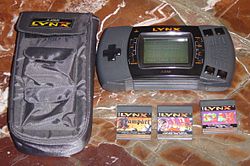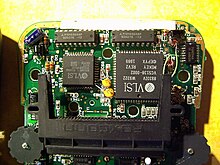Atari Lynx
| Atari Lynx | ||||
|---|---|---|---|---|
 |
||||
| Manufacturer | Atari Corporation | |||
| Type | Handheld console | |||
| generation | fourth generation of consoles | |||
| publication |
|
|||
| Main processor | MOS Technologies 6502 | |||
| Storage media | Modules | |||
| Units sold | 3 million units | |||
| Most successful game | APB | |||
The Atari Lynx is the first handheld console with a color screen and was manufactured by Atari Corporation in the 1990s.
description
The Lynx was originally developed by the game company Epyx under the code name "Handy", which was primarily known for its sports games for the Commodore C64 . Atari bought the console and finished developing it.
The Lynx was introduced to the American public in the summer of 1989. Atari delivered only a few copies to dealers until the end of the year, so Christmas sales were made with Nintendo's competitor, the Game Boy, which was also presented in the summer of the same year. Sales also remained sluggish in 1990. In 1991 Atari launched a model overhaul of the Lynx called the Lynx II. The Lynx II differs from the previous model in that it has a more compact housing, the ability to switch off the background lighting of the display and stereo sound at the headphone output . Inserting the memory modules is also a simple matter of the Lynx II and is no longer so stiff.
The graphic possibilities offered by the Lynx were revolutionary for a handheld at the time. The Lynx's liquid crystal screen had a resolution of 160 × 102 pixels and was able to display 16 colors from a total of 4096 colors. The screen was backlit so that it could be played in complete darkness. The display quality of the LC display is, however, not comparable with today's color displays - such as those built into cell phones or the portable consoles from Nintendo and Sony . The contrast was weak by today's standards and the viewing angles were very narrow.
The Lynx is capable of hardware scrolling and sprites and has a graphics chip (often incorrectly called a 3D chip) that can rotate and scale raster graphics . The console can be switched to left-handed operation at the push of a button . The image and the assignment of the control pad are then rotated 180 degrees. Up to eight Lynx consoles can be connected for multiplayer games via the so-called ComLynx port. The Lynx can operate for around four to five hours with fresh batteries . The high battery consumption is primarily due to the backlighting of the screen. Atari there was an adapter for the 12-volt on-board socket ( cigarette lighter ) that is common in cars and other vehicles .
Most games for the Lynx are conversions of classic Atari / Midway machines, but the console also offers very good conversions of computer games such as Lemmings . To date, developing home developing games for the console. The games are saved on memory cards (gamecards).
The Lynx was released on November 26, 1989, five months after the Game Boy , but did not even begin to reach its sales figures due to the high price, high battery consumption, comparatively voluminous dimensions and, last but not least, poor marketing by Atari. In addition, successful games like Super Mario Land for the Lynx were missing . The device is rarely seen today. But there is still a fan base that continues to develop for the Lynx.
Technical specifications
Dimensions
- Lynx Classic: 27.3 cm × 10.8 cm × 3.8 cm
- Lynx II: 23.5 cm × 10.8 cm × 5.1 cm
- Display diagonal: approx. 8.9 cm
hardware
The hardware consists of two CMOS chips specially manufactured for the Lynx :
-
Mikey (8- bit CMOS chip)
- MOS 65SC02 processor clocked with 4 MHz , 8-bit CPU, 16-bit address space
- Sound engine for 4-channel stereo sound with 8- bit resolution per channel. Real stereo only from Lynx II (PAG-0401)
- Video driver for liquid crystal display
- 8 system timers (cascadable, two reserved for video timing, one for UART )
- Interrupt controller
- Serial interface (for ComLynx) up to 62,500 baud
- 512 bytes boot ROM
-
Suzy (16-bit CMOS chip clocked at 16 MHz)
- Graphics engine
- Mathematical peripheral unit for 16x16 = 32 bit multiplication (optionally with adding up) and 32/16 = 16 bit division (parallel to the CPU)
- 64 KiB main memory (120 ns )
The game cards offer up to 2 MiB storage space . However, only 128 KiB, 256 KiB and 512 KiB cards are common, larger cards require a bank switch logic.
Some (unofficial) cards contain EEPROMs for saved games.
Games
The best-known titles for the Lynx include, for example:
See also Category: Lynx Game .
Web links
- AtariAge
- Atari Lynx FAQ
- Atari Lynx
- Atari Lynx in the Atari Museum
- German-language Atari Lynx info page ( Memento from February 1, 2015 in the Internet Archive )
- Handy - Lynx Emulator
- Hardware info (english)
- neXGam.de Tests and Specials for the Atari Lynx (German)
- Article with device description: Atari Lynx - The pocket-sized lynx ( Memento from September 7, 2011 in the Internet Archive )
- Lynx Development / Hardware Info
Individual evidence
- ↑ GameBoy: Why it beat the technically superior competition from Atari and Sega. In: retrovideospiele.com. Retrieved December 14, 2019 .
- ^ The top-selling Lynx games. In: vgchartz.com. Retrieved December 14, 2019 .
- ↑ a b A Lynx for every pocket , from: Power Play , issue 2/1990, pages 6 and 7. (Back then as a free supplement to Happy Computer , issue 2/1990.)
- ↑ Hardware graphics accelerator

